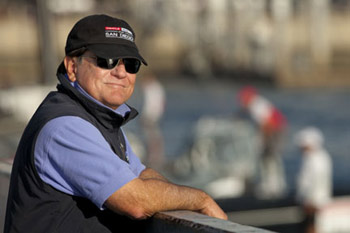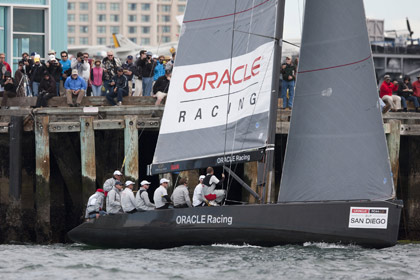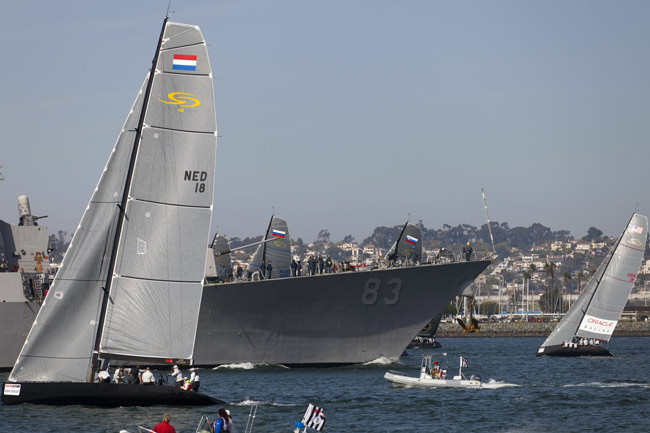Hosting the ACWS in San Diego: Bringing the Cats
SEA San Diego's John Laun: Interview
November 4, 2011
 |
|
|
SEA San Diego's John Laun. Photo:©2011
Christy Radecic |
In a few short days, the America’s Cup returns to San Diego, the Auld Mug’s home from 1987 to 1995, when Team New Zealand and Black Magic snatched it away in a dominating performance. But this time around the action won’t happen out at sea, out of mind of all but the most hardcore sailing fans. “Stadium sailing” is coming to San Diego, promising enough thrills, chills, and spills to entice a whole new generation of fans.
John Laun, lifelong sailboat racer and owner of the San Diego Yacht Club-based J/120 Caper, watched the America’s Cup making its “victory tour” around San Diego in 2010 and knew the city still had the interest and the ability to run a Cup regatta. He and Chuck Nichols, former SDYC commodore and 1995 AC President, formed Sailing Events Association (SEA) San Diego to make that goal a reality. On the eve of the America’s Cup World Series in San Diego, Laun talked to CupInfo about the steps they took to secure the regatta, lessons learned, and what it will take for the event to be a success in his view:
“We formed the Sailing Events Association San Diego to pursue America’s Cup regattas,” explained Laun. “It was clear early on that if we could demonstrate our capabilities and showcase San Diego -- our team, our environment, our stadium sailing concept -- that it would promote ourselves as a viable venue.”
Step one was to host an event to demonstrate to the America’s Cup Event Authority (ACEA) that SEA was capable of staging a major regatta inside San Diego Bay, including providing facilities for teams on the downtown piers, spectator viewing options on and around the race course, on-the-water race management, and plenty of waterfront entertainment. Enter the RC44 class; for their first event SEA signed the international one-design fleet for a west coast stop. The regatta in March, 2011, featured the top RC44 teams from around the world, with names familiar to America’s Cup fans, such as Russell Coutts, Paul Cayard, Cameron Appleton, and Paolo Cian.
“We wanted to host a spectator event that people could enjoy, something that would energize the San Diego community around sailing. It was our first event and it was exactly on spec for what we wanted -- spectator-friendly and exciting. We had a meeting with the ACEA the night of the trophy presentation and were up in San Francisco the next week and it was a done deal.”
The RC44 regatta, while successful in its own right, was designed as a dress rehearsal for an even bigger show. Laun details the items learned from that first experience.
“First, the facilities that the Port has on the Embarcadero (the waterfront area that lines the downtown portion of San Diego Bay) were fantastic for an event such as that. Second, sailing in San Diego Bay is exactly right for the stadium sailing concept -- the legs were the perfect length and the viewing possibilities for spectators are excellent. Lastly, and I guess I should have known this, but the number of people in San Diego who are excited about racing and want to volunteer to help is amazing. We had lots of people showing up to help and we’re seeing the same thing now before the America’s Cup World Series.”
The America’s Cup World Series is a much bigger event than the RC44 regatta, however, and Laun and his team had a major task ahead and not much time to get it done with the November ACWS date a mere eight months away. The fact that the SEA’s role in the ACWS regatta was much different than for the RC44 event didn’t make the task any easier.
“We always knew it would be hard, because we had a very compressed time frame. And there was a lot to learn -- the RC44 regatta and the America’s Cup World Series are very different in terms of our role, and certainly the America’s Cup World Series is a much more complex event.
 |
|
|
Photo: ©2011 Gilles Martin-Raget/Oracle
Racing |
“For the RC44 regatta, we were the organizing authority, so we had to raise a substantial amount of money from sponsors and we paid funds to the class for aspects of the regatta. In the case of the America’s Cup World Series, we are the local organizing committee, so with the support of the Port and the San Diego Tourism Marketing District, we are providing the venue and some services. The ACEA and America’s Cup Regatta Management are really running the show. It’s like the Super Bowl, when they came to San Diego it was the same sort of a deal.”
Stadium sailing is the tagline for racing inside San Diego Bay. Doglegs just north of the Broadway Pier area help create a natural amphitheatre for the races, though the arrangement inside the busy working harbor raised complications and required involving several high-level entities in the planning process. Laun appreciates the level of support SEA received from the myriad of interested parties.
“We’ve had great cooperation from the Navy, the Coast Guard, and the Port’s Harbor Police. In addition to that we have commercial operators like the tour boats that operate in the bay, the ferries, Troy Sears' America’s Cup Experience and Stars & Stripes. There’s been a lot of outreach, a lot of meetings with the impacted groups. We have an exclusion zone we have defined with the Coast Guard, and are working through the details on how to manage that and provide the course marshalling. So I think it will be something that will work well within the Bay, but not without effort.
Complications don't end at the water's surface, the airspace is an additional dimension of challenges. "The race course is situated between North Island Naval Air Station (NAS) and Lindbergh Field, San Diego’s international airport," says Laun. "So in order to get the technology off the boats for the TV coverage, the helicopters have to be flying in a very sensitive and congested air space." SEA had to coordinate with the US Navy, Lindbergh operations, and the FAA office as well, all of whom were receptive and helpful. "It’s been an amazing process, to see everyone pull together.”
The stadium sailing concept also brings new challenges for the sailors, many of whom have experience racing in major San Diego regattas, albeit mostly outside the harbor on the usual NOOD or Yachting Cup race courses. Fewer have raced inside the bay and had a chance to learn its quirks such as tidal effects, wind channeling between the tall downtown buildings, and the chop from hundreds of pleasure craft, but, as Laun points out, the world’s top sailors know their stuff, whether they have sailed there before or not.

|
|
|
Photo: ©2011 Gilles Martin-Raget/Oracle
Racing |
“In the RC44 regatta, we saw that the good guys figured it out very quickly. Certainly anyone who has sailed beercan races here in the north bay knows that there are nuances. We think we have figured it all out over time, but these guys, who had never seen the bay before, came in and figured it out in one race. There are nuances -- the current does have an impact and there are some rather reliable geographic shifts, but the best sailors will figure it out quickly.”
The chop the ACWS sailors face will be a function of the number of spectator craft, so among the major questions as the regatta approaches is the degree of interest in San Diego. While the area is a major sailing mecca, there remains a local element that still refers to the Cup’s tenure here as the “Coma off Point Loma.” Laun’s job has been to not only get the word out about the excitement factor with the AC45 catamarans, he’s got to explain to those “in the know” that this is not the America’s Cup as they remember it from the 1990s.
“We have a lot of people who think they know all about sailing because of the past history, so there’s a little bit of explanation required about how this is so very different. And then there’s the whole desire to reach out to non-sailors. San Diego has a very rich heritage with extreme sports, so there are a lot of people here who get excited about the kind of high-energy athletic, and at times dangerous, things like this sailing is going to be. So the job is getting the attention of the media, not only to express that this is different from the America’s Cup they’re used to, but also convince the media to help us reach out to people who don’t consider themselves sailing fans, but extreme or action sports fans.
“There are some who have strong opinions that will be hard to change, but others with open minds are giving us very good coverage. Certainly, the early events from Cascais and Plymouth have been exciting and the media have seen something there. All the technology that the ACEA is putting into this, to get the great images off the water, and what they’re calling ‘sailing from the inside out’ -- all of the action, the camera and the audio from onboard the boats -- is helping that. There’s a lot more for the media to play with than ever before.”
Laun knows there’s quite a bit at stake for this America’s Cup World Series event, and he knows what the end result needs to be for him to deem it a success.
“First and foremost, it has to be a great sporting event," Laun says. "We want to make sure that San Diego delivers the conditions we’re counting on, so that the racing is fun and exciting. We certainly were blessed with that in the RC44 regatta; it couldn’t have been more perfect. We hope to have a repeat, naturally."
“And we want it to be a great fan experience, because our success as an organization, and the America’s Cup success going forward, is based upon this being a spectacle that gets everybody's attention. So we want to make sure that all the things we’re doing around the bay to provide a good venue, good viewing and excitement for the spectators, are there. The ACEA is not relying solely on the racing -- there are a lot of other things around the event, like the public being able to see the ‘pit row’ where the boats are prepped and worked on. That has proved to be very exciting at the first two stops. And there will be entertainment and other activities around the AC village. So it’s a full package, it’s not just the sailing. So how I would measure success is first the sport, whether we have a good event and secondly, to make sure it’s a fun spectator event as well.”
It’s a badge of honor for SEA San Diego to be part of the first America’s Cup World Series regatta held in the US and to be a part of developing the America’s Cup for the 34th Defense. Laun's perspective is that Cup organizers are figuring out what works and what doesn’t work, taking lessons from each World Series event that will all add together to make the America’s Cup in San Francisco an epic event.
“I think they’re learning a lot about how the technology
can help them put on a great spectacle," says Laun, mentioning, for
example, the ability to quickly adapt the race course to best advantage
even as the race unfolds, hitting targets for elapsed time while providing
fair racing and prime spectator views. But the observation applies
across the board. "They’ve done a lot with their technology and I’m
sure that will take more leaps," Laun adds, going on to note how the
intersecting aspects of the ACWS program are being continuously re-examined
with the ultimate goal in mind. "How to schedule the races so that
you get the right mix of fleet racing and match racing and the right time
of day so that it creates a fun, festival experience -- all those things
have been tweaked in the first two events and I’m sure will be tweaked here
so that when they get to the America’s Cup in 2013, it will be a whole
other ballgame. They’ll stand on the shoulders of everything they’re
learning now.”
---Diane Swintal for CupInfo/©2011 CupInfo.com
Additional Links of Interest:
Also See:
At CupInfo: (March, 2011)
Oracle RC44 Cup in San Diego: A Rehearsal for the America's Cup?
Visit Official America's Cup website
Inquiries please contact: